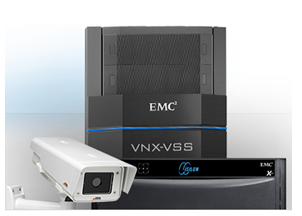 Well I can thankfully say I made it back from EMC World in Las Vegas safe and sound without losing any money from playing Black Jack. But I did gain some insights into how EMC IT customers are thinking about their video surveillance roles, responsibilities, and related challenges within their respective organizations – and not surprisingly – they were relatively similar.
Well I can thankfully say I made it back from EMC World in Las Vegas safe and sound without losing any money from playing Black Jack. But I did gain some insights into how EMC IT customers are thinking about their video surveillance roles, responsibilities, and related challenges within their respective organizations – and not surprisingly – they were relatively similar.
During our conversations, it was evident that their companies growing reliance on video surveillance is helping to drive a booming market. The total video surveillance-related equipment market is projected to grow from $15B in 2014 to nearly $26B in 2018 with Enterprise Storage a fundamental component to that growth.
As the sheer volume of video data they are collecting significantly grows, some indicated they may not have a full awareness or appreciation of the Physical Security or Video Surveillance needs or requirements for their organizations and therefore didn’t know if their infrastructure was prepared for the deluge and the inevitable need for increased storage.
 The major question we heard IT Infrastructure Managers ask themselves is how do they become more involved when it comes to Physical Security decisions? About half of these managers categorized themselves as being influencers in the decision-making process of Physical Security equipment and not just an organization that is the custodian of applications. That’s a good start I guess since video surveillance installations will always involve IT in one way or another – they simply have to – due to the magnitude of what’s involved in an enterprise solution.
The major question we heard IT Infrastructure Managers ask themselves is how do they become more involved when it comes to Physical Security decisions? About half of these managers categorized themselves as being influencers in the decision-making process of Physical Security equipment and not just an organization that is the custodian of applications. That’s a good start I guess since video surveillance installations will always involve IT in one way or another – they simply have to – due to the magnitude of what’s involved in an enterprise solution.
 It’s clear from our IT customers that they’re very comfortable in managing data from traditional applications like OLTP, Data Warehouse, Virtual Applications, Video Editing and more on EMC storage. However, some also recognized that in order to feel as comfortable in managing video data they needed to start treating video as just another application. The reason is straightforward – video data is meeting at the same enterprise storage infrastructure that IT is already managing.
It’s clear from our IT customers that they’re very comfortable in managing data from traditional applications like OLTP, Data Warehouse, Virtual Applications, Video Editing and more on EMC storage. However, some also recognized that in order to feel as comfortable in managing video data they needed to start treating video as just another application. The reason is straightforward – video data is meeting at the same enterprise storage infrastructure that IT is already managing.
 Taking steps to improve collaboration and convergence with Physical Security – that will also better define ITs’ role in the process – will help IT ensure the right video surveillance infrastructure is in place and remove any notion that Physical Security is a shadow IT organization that contradicts what IT is trying to accomplish. The message was clear that IT customers are not interested in alienating the Physical Security professionals and want to create a stronger partnership/relationship with them that ensure infrastructure decisions are keeping pace with video surveillance trends such as virtualization, more cameras, higher resolution rates, longer retention periods, IP-based infrastructure, analog to digital, video analytics, and converged infrastructure solutions.
Taking steps to improve collaboration and convergence with Physical Security – that will also better define ITs’ role in the process – will help IT ensure the right video surveillance infrastructure is in place and remove any notion that Physical Security is a shadow IT organization that contradicts what IT is trying to accomplish. The message was clear that IT customers are not interested in alienating the Physical Security professionals and want to create a stronger partnership/relationship with them that ensure infrastructure decisions are keeping pace with video surveillance trends such as virtualization, more cameras, higher resolution rates, longer retention periods, IP-based infrastructure, analog to digital, video analytics, and converged infrastructure solutions.
 It’s only in this collaborative and convergent manner that companies concerned with protecting people and assets will be able to be fully assured of implementing a video surveillance infrastructure that is open and flexible, scalable and reliable, simple and manageable, validated and tested. And based on what we heard from customers, EMC’s Edge to Core Video Surveillance enterprise solution model – with VNX and Isilon – goes beyond what they’ve seen in appliance-based systems. Not only is EMC’s enterprise model cost effective and less complex to manage, it also has no vendor lock-in enabling overall faster innovation. In all, EMC’s Edge to Core Video Surveillance enterprise approach combines affordability, efficiency, scale, and simplicity to meet all surveillance infrastructure expectations.
It’s only in this collaborative and convergent manner that companies concerned with protecting people and assets will be able to be fully assured of implementing a video surveillance infrastructure that is open and flexible, scalable and reliable, simple and manageable, validated and tested. And based on what we heard from customers, EMC’s Edge to Core Video Surveillance enterprise solution model – with VNX and Isilon – goes beyond what they’ve seen in appliance-based systems. Not only is EMC’s enterprise model cost effective and less complex to manage, it also has no vendor lock-in enabling overall faster innovation. In all, EMC’s Edge to Core Video Surveillance enterprise approach combines affordability, efficiency, scale, and simplicity to meet all surveillance infrastructure expectations.
Now back to learning how to play Black Jack…
Learn More about EMC Video Surveillance